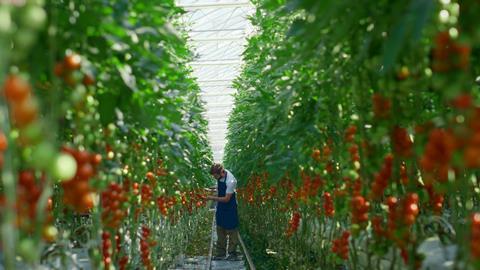Cost pressures, supply chain disruption, and the threat of ToBRV are taking their toll on the British tomato sector, but Alex Margerison-Smith of Keelings sees opportunities for innovative growers with a focus on premium varieties
What are the main trends and talking points in the UK tomato sector at the moment?
- Extreme cost pressures: UK tomato growers are facing continued high input costs – primarily energy, but also labour, packaging and fertiliser. This is making it difficult to remain profitable.
- Supply chain disruption: the collapse of some growers, challenging weather conditions, the shortage of labour, Tomato Brown Rugose Virus (ToBRV), and increased border checks and costs are all present challenges to the sector.
- Alternative crops: some growers are diversifying into other greenhouse crops.
- Innovation and sustainability: growers and researchers are looking into ways to reduce energy reliance, optimise production techniques, and combat pests and diseases in a sustainable manner.
The UK greenhouse sector has had a number of recent casualties amid extreme cost pressures on growers, the most recent being UK Salads. Can we expect further businesses to go into administration in the months ahead?
The collapse of UK Salads highlights the fragility of the UK greenhouse sector in the face of extreme cost pressures. Smaller growers or those without long-term contracts are especially vulnerable, and further casualties cannot be ruled out if costs don’t stabilise.
Despite the difficulties of the glasshouse sector, there has been some recent expansion in soft fruit. For example, The Summer Berry Company has invested in year-round strawberry production. Has there been any similar investment in tomatoes, or do you see any on the horizon?
Before the energy crisis, there was an increase in the area dedicated to growing tomatoes during the winter season. However, the high cost of energy made this practice economically unsustainable, leading to a significant reduction in the area under cultivation.
If energy prices continue to decline, this trend could reverse, with a return to increased winter tomato production.
Given the cost pressures they are already under, are UK tomato growers going to be able to cope with the increase of the National Living Wage to £11.44 per hour? And how are they going to be able to compete with imports from countries such as Morocco where the cost of production is much lower?
The increased National Living Wage adds to the pressure of rising labour costs, squeezing UK growers’ profitability. While competing with lower-cost imports is a challenge, UK growers can maintain an edge by focusing on premium tomatoes. This strategy targets those UK consumers who are willing to prioritise quality.
How likely is it that we’ll see more shortages of salad vegetables such as tomatoes at UK supermarkets this year and why?
While it’s impossible to definitively predict future shortages, the increased frequency of extreme weather poses a significant risk to the supply chain’s stability.
How are tomato imports to the UK likely to be affected by the introduction of physical border checks on plants (in April) and fresh produce (in October)?
The introduction of border checks on plants and fresh produce will add complexity and potential delays to imports. This could disrupt supply chains and lead to increased costs for imported tomatoes, potentially affecting availability for shoppers.
How are UK growers protecting themselves against the threat of ToBRV?
UK growers are implementing strict hygiene and biosecurity protocols to prevent ToBRFV introduction and spread. This includes measures like restricting access to greenhouses, sanitising equipment and people, and sourcing seeds and plants from reliable sources.
Ongoing research is focused on developing resistant varieties and better detection methods.
What is the current state of play when it comes to the spread of the virus in Britain?
While there have been some isolated ToBRFV outbreaks in the UK, vigilant biosecurity measures have largely contained widespread dissemination. The situation remains dynamic, and growers must remain attentive to the threat.
How has the threat of ToBRV affected what varieties are grown in the UK?
Growers are increasingly choosing varieties with ToBRFV resistance or tolerance to reduce the risk of crop losses. This is limiting the choice of varieties.
What opportunities do you see to improve the marketing of taste in tomatoes at UK retailers?
To truly showcase the great taste of tomatoes, there are two strategies that could be employed:
- Celebrate British seasonality: highlight the unique flavours of peak-season British tomatoes. Partner with growers to promote freshness, quality, and the ‘grown-close-to-home’ advantage.
- Innovate and engage: take inspiration from successful campaigns like Walkers’ ‘do us a flavour.’ Launch a competition for new, premium tomato varieties, inviting shoppers to vote for their favourites. This creates excitement, encourages trials of new flavours, and potentially drives shoppers towards higher-tier purchases.
These strategies go beyond simply offering tasty tomatoes; they create a story and experience that resonates with consumers.
Some major suppliers in Europe have expressed concern that there are now too many tomato SKUs at the supermarket. Do you think this is the case in the UK? Is more consumer education needed?
While the current abundance of tomato SKUs offers choice, it risks overwhelming shoppers. In-store shopper education is challenging due to the limited ability to effectively review all the possibilities.
A more effective approach would be restructuring the tomato display based on usage (e.g. snacking, slicing, cooking) with clear tiered options (e.g. good, better, best). This simplifies the selection process, potentially improving shopper satisfaction and sales.




